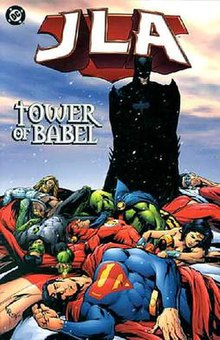

This article needs additional citations for verification. Please help improve this articlebyadding citations to reliable sources. Unsourced material may be challenged and removed.
Find sources: "JLA: Tower of Babel" – news · newspapers · books · scholar · JSTOR (July 2008) (Learn how and when to remove this message) |
| "Tower of Babel" | |
|---|---|

Cover of JLA: Tower of Babel (2001, trade paperback edition), art by Howard Porter.
| |
| Publisher | DC Comics |
| Publication date | July – October 2000 |
| Genre | |
| Title(s) | JLA #43–46 |
| Creative team | |
| Writer(s) | Mark Waid |
| Penciller(s) | Howard Porter Steve Scott |
| Inker(s) | Drew Geraci Mark Propst |
| Colorist(s) | John Kalisz |
Tower of Babel is a 2000 comic book storyline that ran in the DC Comics monthly series JLA #43–46. It was written by Mark Waid.
Tower of Babel deals with Batman's perceived betrayal of the superhuman community by keeping and concealing hidden records concerning the strengths and weaknesses of his allies in the JLA, which include plans to neutralize his allies in a fight. His files are stolen by the criminal mastermind Ra's al Ghul, who uses them to defeat the League through a coordinated attack in order to prevent them from interfering with his latest scheme toward reduction of the global population.
The attack briefly but effectively incapacitates the League members long enough for Ra's al Ghul to enact his plans. After they all recover, the JLA must also deal with Ra's al Ghul's attack against the language centers of all humanity, using a specially-designed tower to generate a low-level sonic signal which causes written language to be scrambled into total nonsense.
Batman's obsessive pursuit to recover his parents' remains leaves him unable to help the League in their temporary defeat until it is too late. At the moment Batman discovers who was behind the robbery and subsequent attack, Ra's al Ghul offers to drop the corpses into a Lazarus Pit which would theoretically revive them. But despite being briefly tempted by the chance, Batman rejects the offer as he would prefer to be worthy of his parents' memory rather than betray it in such a manner. Ra's al Ghul begins the second phase of his attack, scrambling not only the written word, but the spoken word as well (similar to stories related about the Tower of Babel).
When League members recover from their injuries and Batman reveals Ra's al Ghul's actions, there is much friction between him and the rest due to his role in devising the traps that nearly killed them. As the effects of the red kryptonite wear off, Superman is able to destroy the machine that is causing the chaos. Ra's al Ghul reveals that a deadly nerve agent is about to be released, sparking a war between two nations already in conflict. As Superman, Batman, and later a restored Aquaman and J'onn move on Ra's' base, Flash, Green Lantern, Plastic Man and Wonder Woman are able to prevent the release of the toxin thanks to Ra's al Ghul's daughter Talia providing them with the locations of the bombs, feeling disgusted at how her father has used her knowledge of Batman to steal his secrets.
Batman states that his plans were a cautionary measure that he devised after the Injustice League swapped bodies with the Justice League with the aid of the alien tyrant Agamemno years earlier (during the Silver Age event). Recognizing the dangers of villains gaining control of the heroes, he created fail-safes in case such a situation ever happened again, the event also inspiring him to create plans to stop the other heroes if they should go rogue on their own. Due to Batman's secretive actions and measures placed against the JLA, the rest of the League vote on whether or not he should remain a member. Wonder Woman, Plastic Man and Aquaman vote for expulsion as they feel that they cannot trust Batman, while Flash, Green Lantern and Martian Manhunter vote against as they recognize that Batman had a point in his reasoning for developing the plans in the first place. It is left for Superman to cast the deciding vote. As they enter the room where Batman is held, the team realizes that he already foresaw how Superman would decide and therefore had already left. Superman is not surprised by this, later saying that Batman would know how he would vote.
IGN Comics ranked JLA: Tower of Babel #14 on a list of the 25 greatest Batman comics, saying that "this compelling story examines the depths of Batman's paranoia, but also shows admiration for his forethought".[1]